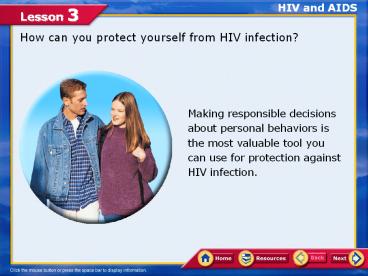HIV and AIDS - PowerPoint PPT Presentation
1 / 19
Title:
HIV and AIDS
Description:
How can you protect yourself from HIV infection? Making responsible decisions about personal behaviors is the most valuable tool you can use for protection against ... – PowerPoint PPT presentation
Number of Views:85
Avg rating:3.0/5.0
Title: HIV and AIDS
1
HIV and AIDS
How can you protect yourself from HIV infection?
Making responsible decisions about personal
behaviors is the most valuable tool you can use
for protection against HIV infection.
2
Lesson Objectives
In this lesson, you will learn to
- Describe how HIV affects and destroys the immune
system - Identify behaviors known to transmit HIV
- Compare the relationships between unsafe
behaviors, refusal skills, and the risk of HIV
infection
3
Teens at Risk
HIV Infection Among Teens
- Teens have one of the fastest growing rates of
human immunodeficiency virus (HIV) infection. - Many young adults who are currently dying from
acquired immune deficiency syndrome (AIDS) were
infected in their teens. - Teens who choose abstinence from sexual activity
and from injecting drugs greatly reduce their
risk of HIV infection.
4
HIV and the Human Body
How HIV Infects the Human Body
- When HIV enters the blood, it invades certain
cells of the immune system, including T cells,
which help other lymphocytes identify and destroy
pathogens. - The viruses take over the cells, cause them to
produce new copies of themselves, and the newly
produced viruses break out of the cell,
destroying them. - The new viruses infect other cells, and then the
process repeats itself.
5
HIV and the Human Body
How HIV Attacks Cells
6
HIV and the Human Body
HIV Infection and AIDS
- HIV infection is progressive that is, it
destroys the cells of the immune system over many
months or years. - As the number of viruses increases, the body
becomes susceptible to common infections and to
opportunistic infections. - Being infected with HIV does not necessarily mean
that an individual has AIDS. - AIDS is the advanced stage of HIV infection.
7
How HIV Is Transmitted
Nature of the HIV Virus
- The HIV organism lives inside cells and body
fluids. - It doesnt survive well in the air or on surfaces
such as toilet seats or telephones. - It cannot be transmitted through food.
- HIV can be transmitted from an infected person to
an uninfected person only through blood, semen,
vaginal secretions, and breast milk.
8
How HIV Is Transmitted
Transmitting HIV Through Sexual Intercourse
- HIV can be transmitted during any form of sexual
intercourse. - During intercourse, secretions containing HIV can
enter a partners blood through tiny cuts in the
body. - The risks of HIV infection increase with the
number of people with whom a person is or has
been sexually active. - Having an STD that causes sores, including
chlamydia, genital herpes, gonorrhea, or
syphilis, increases the risk of HIV.
9
How HIV Is Transmitted
Transmitting HIV by Sharing Needles
- If a person who is infected with HIV injects
drugs, the needle or syringe can become
contaminated with that persons blood. - Anyone who uses that same needle or syringe can
inject HIV directly into his or her bloodstream. - Injections under the skin or in the muscle also
can spread HIV.
10
How HIV Is Transmitted
Transmitting HIV from Mother to Baby
- A pregnant female who is infected with HIV can
pass the virus to her baby. - HIV in the mothers blood can be transmitted
through the umbilical cord and during delivery. - Because breast milk can contain HIV, a baby can
receive HIV while nursing.
11
Quick Review
Choose the appropriate option.
Q. The rate of HIV infection in the teen
population is decreasing because of abstinence
from high-risk behaviors such as injecting drugs
and engaging in unprotected sexual activity.
True
False
12
Quick Review - Answer
A. False. The rate of HIV infection in the teen
population is increasing because of high-risk
behaviors such as injecting drugs and engaging in
unprotected sexual activity.
Click Next to attempt another question.
13
Quick Review
Choose the appropriate option.
Q. HIV attacks by entering cells of the immune
system, where it makes more viruses that break
away and attack other cells.
True
False
14
Quick Review - Answer
A. True. HIV attacks by entering cells of the
immune system, where it makes more viruses that
break away and attack other cells.
Click Next to attempt another question.
15
Quick Review
Choose the appropriate option.
Q. HIV is transmitted through sexual intercourse,
sharing contaminated needles, and from mother to
baby.
True
False
16
Quick Review - Answer
A. True. HIV is transmitted through sexual
intercourse, sharing contaminated needles, and
from mother to baby.
Click Next to attempt another question.
17
Quick Review
Choose the appropriate option.
Q. There is no relationship between unsafe
behaviors, refusal skills, and the risk of HIV.
True
False
18
Quick Review - Answer
A. False. There is a direct relationship between
unsafe behaviors, refusal skills, and the risk of
HIV.
Click Next to attempt another question.
19
End of Lesson 3
Click Home to view the Main menu.































